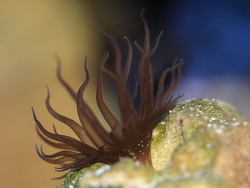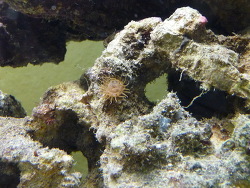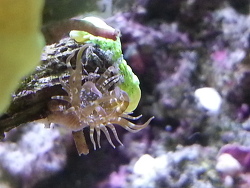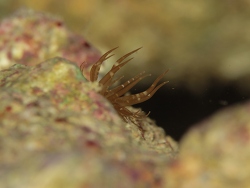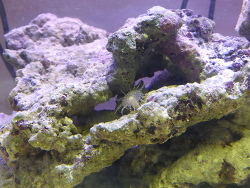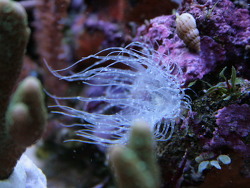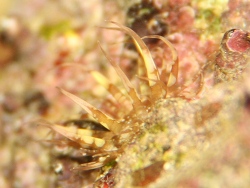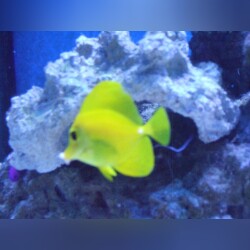Info
Exaiptasia diaphana (Rapp, 1829)
This species is known to every marine aquarist as the pest anemone "Aiptasia" or "Exaiptasia".
In 2014, Grajales and Rodriguez showed that it differs from true Aiptasia species in some significant ways and created a new genus Exaiptasia for it.
Glass anemones (Aiptasia) are members of the sea anemone family and are common in all oceans worldwide.
The strong stinging power of glass anemones and their high reproduction potential make these, actually quite pretty, sea anemones unfortunately unloved aquarium inhabitants and a real nuisance. They are often introduced with live stones, sometimes unfortunately also with coral offshoots and are extremely hard to handle. Therefore you should not wait with the fight against glass lice, but in any case do something immediately!
Glass lice can strongly entangle other corals. They stretch out in length and can thus crowd neighboring corals. These turn white at the touched areas and can even die completely.
Some corals - especially Stylopora, Poccilopora, Acropora and Montipora - seem to be particularly sensitive to glass lice. Depending on the size or coral species, this can even lead to the death of entire colonies if the "attack" is noticed too late.
In this way we have unfortunately already lost several small coral offshoots... If glass lice multiply too much, this can be very detrimental to the tank climate - other animals then feel visibly "unwell".
There are several methods to fight glass lice successfully or to prevent them from becoming a plague:
For example, the Berghia snail Berghia stephanieae, shrimp such as Lysmata wurdemanni or Lysmata boggessi, and also fish - such as some butterflyfish like Parachaetodon ocellatus and filefish - are suitable predators, as they have glass lice on their menu.
You should never destroy glass lice mechanically! The more food is available in the tank, the faster they grow. Especially Artemia, nauplii, dust food and phytoplankton seem to be "tasty" for them. This means that with each feeding of the remaining inhabitants they always also supply the glass lice..
Synonymised names:
Actinia diaphana Rapp, 1829
Adamsia diaphana
Aipstasia pulchella
Aiptasia agassizii Andres, 1883
Aiptasia californica Carlgren, 1952 (subjective synonym)
Aiptasia diaphana (Rapp, 1829)
Aiptasia inula (Duchassaing & Michelotti, 1864) (subjective synonym)
Aiptasia leiodactyla Pax, 1910 (subjective synonym)
Aiptasia mimosa (Duchassaing & Michelotti, 1864)
Aiptasia minuta (Verrill, 1867) (subjective synonym)
Aiptasia pallida (Agassiz in Verrill, 1864) (new genus created by Grajales & Rodriguez 2014)
Aiptasia pulchella Carlgren, 1943 (subjective synonym)
Aiptasia saxicola Andrès, 1881
Aiptasia tagetes (Duchassaing & Michelotti, 1864) (subjective synonym)
Aiptasiomorpha diaphana (Rapp, 1829)
Aiptasiomorpha leiodactyla (Pax, 1910)
Aiptasiomorpha minuta (Verrill, 1867)
Bartholomea inula Duchassaing & Michelotti, 1864 (original binomen)
Bartholomea tagetes Duchassaing & Michelotti, 1864 (original binomen)
Cribrina diaphana (Rapp, 1829)
Disactis mimosa
Dysactis mimosa Duchassaing de Fombressin & Michelotti, 1864 (original binomen)
Dysactis minuta Verril, 1867 (original binomen)
Dysactis pallida Agassiz in Verrill, 1864 (original binomen)
Exaiptasia pallida (Agassiz in Verrill, 1864) (subjective synonym; epithet diaphana retains priority over pallida (ICZN Opinion 2404))
Paranthea minuta (Verrill, 1867)
Paranthea pallida (Agassiz in Verrill, 1864)
This species is known to every marine aquarist as the pest anemone "Aiptasia" or "Exaiptasia".
In 2014, Grajales and Rodriguez showed that it differs from true Aiptasia species in some significant ways and created a new genus Exaiptasia for it.
Glass anemones (Aiptasia) are members of the sea anemone family and are common in all oceans worldwide.
The strong stinging power of glass anemones and their high reproduction potential make these, actually quite pretty, sea anemones unfortunately unloved aquarium inhabitants and a real nuisance. They are often introduced with live stones, sometimes unfortunately also with coral offshoots and are extremely hard to handle. Therefore you should not wait with the fight against glass lice, but in any case do something immediately!
Glass lice can strongly entangle other corals. They stretch out in length and can thus crowd neighboring corals. These turn white at the touched areas and can even die completely.
Some corals - especially Stylopora, Poccilopora, Acropora and Montipora - seem to be particularly sensitive to glass lice. Depending on the size or coral species, this can even lead to the death of entire colonies if the "attack" is noticed too late.
In this way we have unfortunately already lost several small coral offshoots... If glass lice multiply too much, this can be very detrimental to the tank climate - other animals then feel visibly "unwell".
There are several methods to fight glass lice successfully or to prevent them from becoming a plague:
For example, the Berghia snail Berghia stephanieae, shrimp such as Lysmata wurdemanni or Lysmata boggessi, and also fish - such as some butterflyfish like Parachaetodon ocellatus and filefish - are suitable predators, as they have glass lice on their menu.
You should never destroy glass lice mechanically! The more food is available in the tank, the faster they grow. Especially Artemia, nauplii, dust food and phytoplankton seem to be "tasty" for them. This means that with each feeding of the remaining inhabitants they always also supply the glass lice..
Synonymised names:
Actinia diaphana Rapp, 1829
Adamsia diaphana
Aipstasia pulchella
Aiptasia agassizii Andres, 1883
Aiptasia californica Carlgren, 1952 (subjective synonym)
Aiptasia diaphana (Rapp, 1829)
Aiptasia inula (Duchassaing & Michelotti, 1864) (subjective synonym)
Aiptasia leiodactyla Pax, 1910 (subjective synonym)
Aiptasia mimosa (Duchassaing & Michelotti, 1864)
Aiptasia minuta (Verrill, 1867) (subjective synonym)
Aiptasia pallida (Agassiz in Verrill, 1864) (new genus created by Grajales & Rodriguez 2014)
Aiptasia pulchella Carlgren, 1943 (subjective synonym)
Aiptasia saxicola Andrès, 1881
Aiptasia tagetes (Duchassaing & Michelotti, 1864) (subjective synonym)
Aiptasiomorpha diaphana (Rapp, 1829)
Aiptasiomorpha leiodactyla (Pax, 1910)
Aiptasiomorpha minuta (Verrill, 1867)
Bartholomea inula Duchassaing & Michelotti, 1864 (original binomen)
Bartholomea tagetes Duchassaing & Michelotti, 1864 (original binomen)
Cribrina diaphana (Rapp, 1829)
Disactis mimosa
Dysactis mimosa Duchassaing de Fombressin & Michelotti, 1864 (original binomen)
Dysactis minuta Verril, 1867 (original binomen)
Dysactis pallida Agassiz in Verrill, 1864 (original binomen)
Exaiptasia pallida (Agassiz in Verrill, 1864) (subjective synonym; epithet diaphana retains priority over pallida (ICZN Opinion 2404))
Paranthea minuta (Verrill, 1867)
Paranthea pallida (Agassiz in Verrill, 1864)







 Prof. Dr. Peter Wirtz, Madeira
Prof. Dr. Peter Wirtz, Madeira



